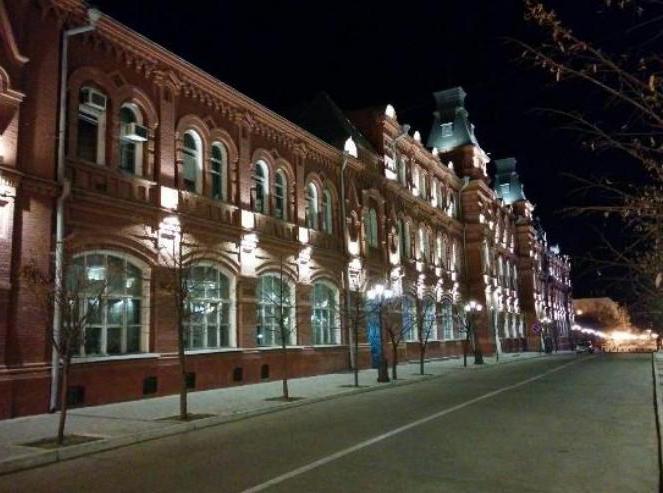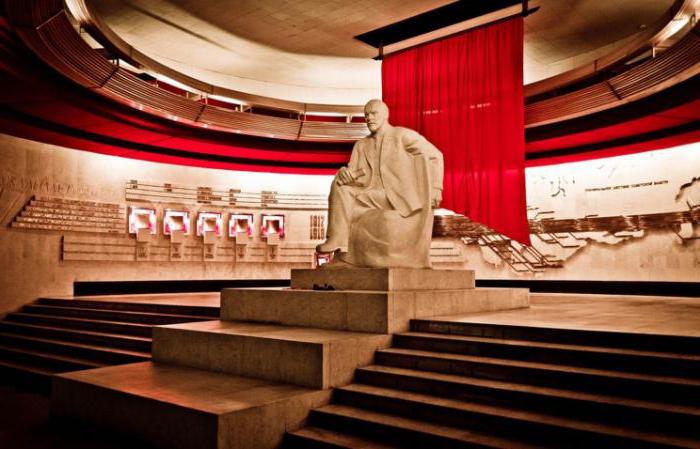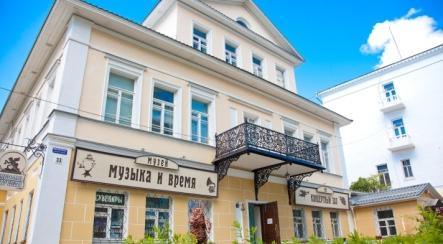The Yaroslavl Museum-Reserve. Yaroslavl State Historical, Architectural and Art Museum-Reserve
Many travelers are attracted todayYaroslavl. Sights, the description of which can be found in any tourist brochure, pleases the eyes of the guests of the city and local residents. We will talk about one of them today.
Travelers, visiting the districts of Yaroslavl, simply can not miss the Transfiguration Cathedral, located in the heart of the city.

And they are sometimes surprised to learn that this buildingbelongs not to the church, but to the museum. The Yaroslavl Museum-Reserve is one of the largest cultural institutions of the city of Yaroslavl. In addition, it is an important tourist site. In the year about 600 thousand people visit it. The full name of this museum, by the way, is not easy: "Yaroslavl State Historical, Architectural and Art Museum-Reserve".
Short description
Since 1959 this cultural object has been in thethe center of the city, in the building occupied by the former Transfiguration Monastery, which was abolished in 1787. A rich history of manuscripts and icons, church utensils and precious fabrics, as well as works of ancient Russian art belongs to this museum. On its territory there is a building belonging to the beginning of the 16th century and being the oldest surviving in the complex. This is the Transfiguration Cathedral. The museum, in addition, includes 6 churches, which are important monuments of painting and architecture of the 17th century.
History of the museum
In 1865, on January 12 (25), was opened at theThe society created for the natural history study of the province (the full name of it will not be given), the first museum. Its founder was Petrovsky Andrey Stanislavovich, professor of natural history. The society in 1901 was renamed into a natural-historical one, and after that a large entomological collection was formed. The natural-historical museum was in the beginning of the 20th century one of the largest museums in Russia, located in the province.
In 1895 the Ancient Depository was created. It was a historical museum, whose task is to protect and study the cultural and historical heritage of the region. His collection numbered 100 exhibits in 1895, and in 1914 it increased as much as 12 thousand titles.
In 1924 two museums united and formedYaroslavl State Regional Museum. The former Drevleshranilishche (a historical and archaeological museum), a museum of ancient Russian art (the art gallery opened in December 1919), a natural history museum and a scientific library were included in its composition. He began to obey in 1928 the Provincial Museum Administration.
As a result of the repeated transformations that occurred in the 20th century, this cultural object acquired the status of a reserve.
Savior Transfiguration Monastery
In a unique architectural ensemble, whichwas previously a monastery, the main expositions of the museum of interest are located. One of the best monuments of architecture of our country is the Transfiguration Monastery, built in 1516.

Construction commissioned Vasily III, Grand Duke. The work was carried out by the Moscow artel, led by an Italian master. He was one of those that the Moscow Kremlin reconstructed in its time. The times of the reign of Ivan the Terrible belong to the murals of the temple. They were executed from 1563 to 1564. This is one of the two surviving ensembles of monumental paintings dating back to this time, as well as the only one with full attribution (we know the names of artists, the date of painting). Built in the form of a powerful wall in the 16th century, the lower part of the belfry gives some idea of this type of structures related to the architecture of Ancient Rus. Completed in the early 19 th century, the upper part of it has a viewing platform, the only one of its kind in Yaroslavl. It allows you to see the entire protected part of this city, which was included by UNESCO in the list of objects of world cultural significance.

Refectory Chamber and other monuments of the reserve
Relating to the year 1516, the Refectory wasIt is built on the model of Granovita, located in the Moscow Kremlin. Monuments of the 16th century, such as the Holy Gate, the fortress tower of the ensemble (the first and main), the main entrance to the monastery, are part of the fortifications of the ensemble. By the 17th century, the Uglich tower, which has a large archway in the lower part (it served to travel from Uglich to the Yaroslavsky Posad), as well as the Bogoroditskaya tower with a large basement, in which, possibly, in the Middle Ages, an underground passage began.
5 bright monuments of the 17th century, which Mr. Yaroslavl, are part of this reserve. They characterize the various stages of the formation and development of the school of Yaroslavl frescoes and temple architecture. These are churches such as St. Nicholas Nadein, dating back to 1622 (murals were made in 1640), the Nativity of Christ, built in 1644 (in 1682, murals were made), Ilia the Prophet (year of construction - 1650th), John the Baptist, presented in the photo below (the year of construction - 1687th, the murals were made in 1696 and 1700) and the Epiphany (the murals date back to 1693, as well as the building itself).

Let's talk about the permanent exhibitions that the Yaroslavl Museum-Reserve offers visitors.
Fair
Visiting this exposition, you will see whichthe fair was many years ago, and will also become a direct participant in this interesting action. You will be able to visit the role of buyer, seller, barkers, as well as other participants in the fair. In your hands can be some items. Giri and changeless, a doll "nurse" and "painting dowry," measures of wine and root, as well as many other rarities can be seen at this exhibition.
Probably, any person has heard at least once about the fairor visited it (and in these days their conduct is actual). I wonder what emotions and thoughts cause the word "fair" in you? Of course, it's screaming, noise, laughter. "Scream", by the way, is a professional concept. So traders and peddlers called the proverbs, with which they sold the goods. Do you know when people first started buying and selling, and what products were exhibited in those ancient times for sale? Answers to these, as well as many other questions you will get by visiting this exhibition, which will acquaint you with the traditions of such a Russian city as Yaroslavl. The reviews suggest that it will be of interest to both children and adults.
"Principality, county, province"

This is another worthy exhibition, whichacquaints visitors with the cultural, economic and political history of the region in the period from 16 to 19 centuries. The three halls are the main milestones in history relating to this period. You will find out what the different districts of Yaroslavl looked like in those days, what was the period of the reign of Ivan the Terrible, the time of the Time of Troubles and the "Golden Age" of this city (17th), the founding of the province, who became the first governor.
This exhibition presents original printedand hand-written books of the 17-19th centuries, the arming of foreign and Russian soldiers, icons of the All-Russian saints and Yaroslavl princes, examples of art of blacksmiths and silversmiths, as well as household items used by residents of such an ancient city as Yaroslavl. Reviews on the exhibition are only positive - there is something to see.
Visitors, other than the above, will seecoins-scales, which were minted in the city during the stay of the militia Minin and Pozharsky (that is, in 1612), when for 4 months Yaroslavl became the temporary capital of the whole state; a unique Swedish coin-plate with a face value of 8 thalers, whose weight is 16 kg (it refers to 1659); as well as the magnificent carriage that the French masters did in the 18th century. This carriage once belonged to Melgunov Alexei Petrovich, the first governor-general of Yaroslavl.
The coats of arms, plans, maps of Yaroslavl, watercolors, paintings, architectural graphics and other exhibits vividly illustrate the social, cultural and political history of this province until the 19th century.
"The Lay of Igor's Host"
Honor of the discovery of this unique monumentbelongs to Musin-Pushkin. However, the history of his discovery remains a mystery to this day. The first edition of The Lay appeared in the autumn of 1800, and after 12 years the manuscript, which was kept in Razgulya, in the house of Mussin-Pushkin, was burnt in the fire that swept the capital during the retreat of Napoleon.
"Word" in Yaroslavl returned a second time. In 1985, an exposition opened in the museum-preserve, the only one of its kind in Russia. The Ilovna Estate is the place where the beginning of the collection of Musin-Pushkin was laid. Today, only visiting the Yaroslavl Museum-Reserve, you can see furniture, works of art, books, and imagine what this manor was in those days. Documents, letters, memorial items, as well as the first edition, which is a bibliographic rarity, give everyone the opportunity to feel ownership of the history of the discovery of this manuscript, its tragic fate, new birth and, of course, immortality.
"Icons of Yaroslavl of the 16th and 18th centuries"

This is another interesting permanent exhibition. The exhibition of icons is a real encyclopedia of Russian art of the 16th and 18th centuries. Solemn and monumental icons, such as the Deesis tier, the "Transfiguration", the Virgin, were created by Yaroslavl and Moscow masters. They were executed in the second half of the 16th century. The 17th century, as you remember, this is the "Golden Age" of Yaroslavl. At that time, many icons were created - John Chrysostom, Ilya the Prophet, John the Baptist, and others. The art of modern times represents the images of John the Warrior, Great Martyr George, Archangel Michael. They combined the baroque style with the traditions of Yaroslavl icon painting. All this you can see by visiting the Yaroslavl Museum-Reserve.
Other permanent exposures
Other permanent exposures includean exhibition entitled "Six-footed masters of our planet", telling about dragonflies, butterflies, grasshoppers, beetles, bees and other representatives of the world of insects. "Treasures of Yaroslavl" is the most important part of the museum collection. In this exposition there are products of masters of medieval Novgorod, Moscow, Yaroslavl, as well as jewelers of our time. You will see the treasures of the sacristy of the temples and monasteries of Yaroslavl, the deposits of rich merchants, local aristocrats and kings. The last exposition from the permanent - "Nature of the Yaroslavl Region." The nature department, represented in this museum-preserve, exists since 1865. Thanks to the skill of Kuznetsov, naturalist, taxidermist, museum worker, sculptor and artist, the exposition acquired a modern look. The department of nature in 1976 was given his name. In this exposition the animal world of the whole Yaroslavl region is represented to the fullest extent. You will find both animals that lived in distant eras, as well as modern fauna. Since the spring of 1992, Masha (the bear, as you know, is a symbol of Yaroslavl) has settled on the territory of the museum. Below is the flag of the Yaroslavl Region.

Branches of the museum
This museum has 3 branches: the Sobinov Memorial House-Museum, the Kosmos Museum and the Battle Glory Museum. Say a few words about "Space", located in the village of Nikulskoe.
The Cosmos Museum
It is dedicated to Valentina Tereshkova. This museum was opened in 1975 and consists of two buildings, which are united in a single complex. The memorial part is a peasant hut, which was restored according to the descriptions of Tereshkova herself, as well as her relatives. Located in a village called Bolshoy Maslennikovo, located 1.5 km from Nikulsky, the parental home was not preserved, so a village house was built after the model of Mother Tereshkova's mother's dwelling, where the family lived during the war. The exposition is in a modern building, specially built. She tells about the life of Tereshkova and other residents of the Yaroslavl region, who contributed to the development of space exploration.








